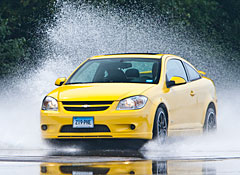With a hurricanes, tropical storms, and fierce winter weather threatening to disrupt travel, it best to get your car ready ahead of such challenges. Our expert tips can steer you in the right direction.
Before a storm approaches, fill your gas tank and have a cell-phone charge cord handy. Should your area lose power, this simple preparation could ensure you can call for help or drive to a safer area.
Worn tires are especially dangerous on slick roads. An easy way to check whether your tires need replacing is to insert a quarter into the tread with George's head facing down. If the top of his head is visible, it's time to buy new tires.
Make sure to check the tire pressure once a month and don't go by the maximum inflation stamped on the side of the tire. See the vehicle owner's manual or the placard on the driver's doorjamb for the proper pressure. (See our tire buying advice and Ratings, as well as our tire-pressure gauge Ratings.)

Worn blades will leave streaks, missed spots, and smears. They could also scratch your windshield. Our tests have shown that even the best blades will show wear after just six months. If you haven't replaced yours in a while, now might be a good time. Check your washer fluid, too, if you haven't done that in a while. (See our wiper buying advice and Ratings.)
Clear the defroster, making sure nothing is blocking the vents, which are on the dashboard at the base of the windshield, and check that it's working properly. Anything blocking it could reduce air flow.
Turn them on and walk around your car to make sure they're all working properly. If you have an older car with hazed lenses that are restricting light, consider using a headlight-restoration kit to freshen them. It is a cost-effective project you can do yourself.
With a little preparation, you will be much better equipped to deal with unexpected roadside emergencies. We recommend you stock your car with a first-aid kit, reflective hazard triangle or flares, tire-pressure gauge, foam tire sealant or a portable compressor and plug, spare fuses, flashlight, gloves, auto-club card or roadside assistance number, $20 in cash, and blanket. The car should be equipped with a jack. It is important to try it at home before you need it on the side of the road... in the rain. You might find that a larger wrench would make removing the lug nuts easier. (See our complete advice on emergency kits.)
Of course, err on the side of safety. In some cases, that may mean staying home rather than braving a storm.
—Jeff Bartlett





